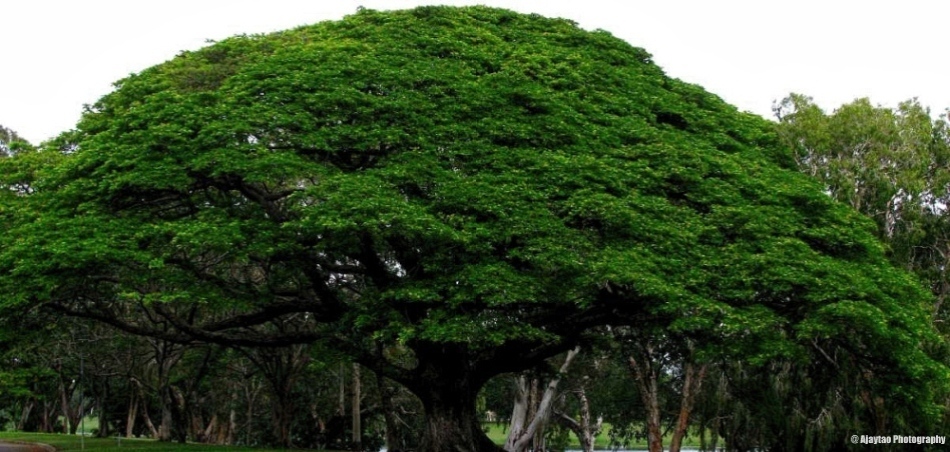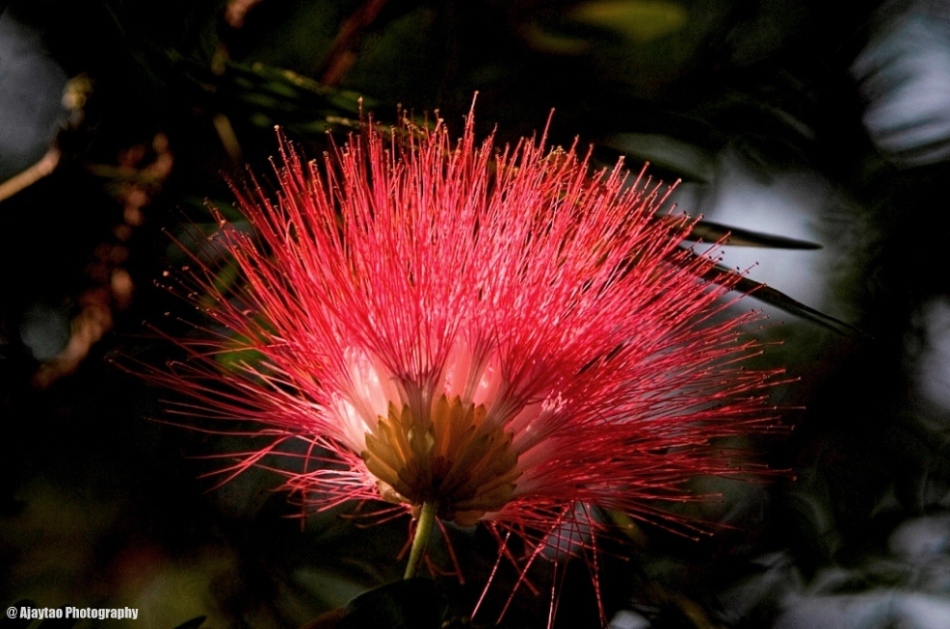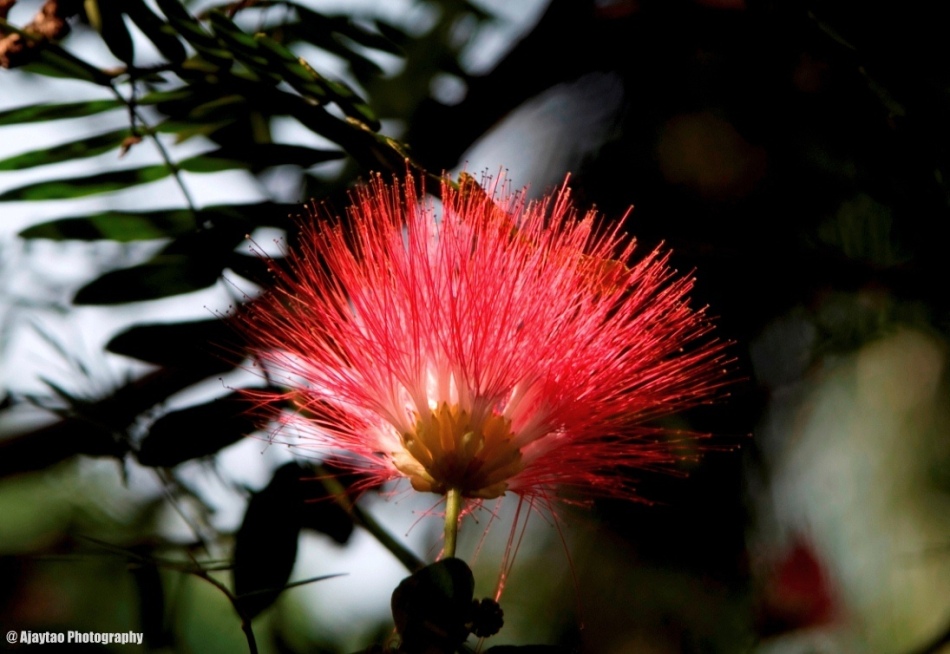Albizia saman – Rain tree – Ajaytao
Common name: Rain Tree, Coco tamarind, Acacia preta, French tamarind, Saman, Monkey pod, Arbre á la Pluie, Cow Bean Tree, Giant Thibet, Inga Saman, Algarrobo, Acacia, Akasya, Palo de China, Cow tamarind, False powder puff, French: Gouannegoul, arbre depluie, Fiji: Vaivai Ni Vavalagi,Vaivai Ni Vavalagi, Japanese: America-nemu, Guam: Trongkonmames. Hawaii: Ohai, pu ohai, Tongan: Kasia kula, mohemobe
Hindi: गुलाबी सिरिस Gulabi Siris, Vilaiti siris
Bengali: Biliti siris • Tamil: Amaivagai, Thoongumoonji maram
Synonyms: Samanea saman, Acacia propinquaMimosa saman, Pithecellobium saman, acutifolium Benth, Samanea (Benth.) Merr, Samanea,
Botanical name: Albizia saman, Samanea saman, Pithecellobium saman,
Family: Fabaceae (Touch-me-not family)
Genus: Albizia
Species: A. saman
Albizia saman (sometimes treated under the obsolete name Samanea saman) is a species of flowering tree in the pea family, Fabaceae, that is native to the Neotropics. Its range extends from Central America, Yucatan Peninsula in Mexico, through Guatemala to Peru, Bolivia, and Brazil to Peru, Hawaii, Florida, Puerto Rico, the Virgin Islands, Guam, and the Northern Marianas. but it has been widely introduced to South and Southeast Asia, India to Sri Lanka as well as the Pacific Islands, including Hawaii. Common names include saman, rain tree and monkeypod It is often placed in the genus Samanea.
Large, handsome and spreading, the Rain Tree is easily recognised by its umbrella like canopy of evergreen, feathery foliage and puffs of pink flowers. It is frequently planted in groups or as an avenue because of its ability to keep its symmetrical conformation in spite of prevailing winds.
It is a tree of rapid growth, brought originally from Central America to Sri Lanka and forwarded from there because it was considered to be a tree of great value for railway fuel. It often reaches a height of 27 m. and the strong, spreading branches may be nearly as long. The bark is dark grey, often bearing horizontal weals and the trunk frequently branches quite low down. From March to May and again towards the end of the year the green canopy is dotted all over with pink and white. During the rest of the year, too, there are usually quite a few flowers to be seen. The flowers appear like round, silken tufts, but actually each flower stalk bears one central and a surrounding circlet of florets, up to twenty in number. Each has a tube-shaped calyx and a tiny, yellow-lobed, crimson trumpet; bunches of long stamens, half pink and half white, protrude from each. The leaves fold in rainy weather and in the evening, hence the name “rain tree” and “five o’clock tree” (Pukul Lima) in Malay Hujan-hujan meaning “rain”, but in India it is believed that the name was given because of a curious habit possessed by the tree of intermittently spraying the ground beneath with moisture.
Several lineages of this tree are available, e.g., with reddish pink and creamish golden colored flowers. The long, heavy leaves are twice pinnate and each pinna, of which there are four to eight pairs, bears from three to seven pairs of leaflets. These are oval and have no stalks, becoming larger and more curved towards the end. on its thickened base so that the leaves all lie sideways. Later it was discovered that this was caused by multitudinous minute insects. The fruit is a fleshy pod, sweet to the taste and much relished by squirrels, horses and cattle. Although generally planted as a shade tree and ornamental, it has been naturalized in many countries and is greatly valued in pastures as shade for cattle. Short-boled, with a spreading crown when open grown, it forms a long, relatively straight stem when closely spaced. Its wood is highly valued in some locations for carvings and furniture.
The Monkey Pod tree is called this perhaps because monkeys are fond of the pods and sit in the trees eating them. The tree’s name in Greek. During his 1799–1804 travels in the Americas, Alexander von Humboldt encountered a giant saman tree near Maracay, Venezuela. He measured the circumference of the parasol-shaped crown at 576 ft (about 180.8 m[3]), its diameter was around 190 ft (about 59.6 m), on a trunk at 9 ft (about 2.8 m) in diameter and reaching just 60 ft (nearly 19 m) in height. Humboldt mentioned the tree was reported to have changed little since the Spanish colonization of Venezuela; he estimated it to be as old as the famous Canary Islands dragon tree (Dracaena draco) of Icod de los Vinos on Tenerife. The tree, called Samán del Guère (transcribed Zamang del Guayre by von Humboldt) still stands today, and is a Venezuelan national treasure. Just like the dragon tree on Tenerife, the age of the saman in Venezuela is rather indeterminate. As von Humboldt’s report makes clear, according to local tradition, it would be older than 500 years today, which is rather outstanding by the genus’ standards. It is certain, however, the tree is quite more than 200 years old today
The tree has nyctinastic leaf movements like Choi-Moi or the Tickle Me plant; its leaves close and curl up at night so that any rain that falls hits the ground more easily than it would under a tree with ordinary leaves. The pods and flowers are nitrogen rich and when they fall and decay, the nitrogen goes into the soil. Plants need this to make chlorophyll which gives them their green colour, so perhaps this is why there is lush vegetation under the Rain tree. Farmers like the trees because they are nitrogen fixers and they also grow quickly, the durable, hard wood is sustainable and eco-friendly so can be used for furniture and hand-carved bowls and decorative pieces. In Thailand the tree is host to the lac insect from which we get shellac.
The flowers attract honey bees as well as birds, moths and other insects, and locals enjoy the honey produced from the nectar, but it is only consumed in the locality of the growing trees.
Medicinal Uses
Saponin-like alkaloid pithecolobin has been isolated from the bark and the seed.
· Alkaloids are said to be abundant in the bark, stems, leaves, and seeds.
· Leaves and stems have saponin and tannin; gum from the trunk.
· Pods are rich in starch and sugar, with a fair proportion of albuminoid substances.
· Bark has no tannin. Trunk yields an inferior gum.
It is used as an Antipyretic, antimicrobial, stomachic, astringent, antidermatoses, laxative, antimalarial, sedative.
In the Philippines, a decoction of the inner bark or fresh cambium and leaves is used to treat diarrhea. Acute bacillary dysentery, enteritis, diarrhea: use 15 to 30 gms dried material in decoction. Also for colds, sore throat, headache. A decoction of the inner bark or fresh cambium and leaves is used to treat diarrhea. Anaphylactic dermatitis, eczema, skin pruritus: use decoction of fresh material and apply as external wash. Latex used as gum arabic for gluing. Seeds chewed for sore throat; inner bark decoction and fresh leaves used for colds and diarrhea.
In Pakistan infusion of leaves used as laxative. Decoction of inner bark used for diarrhea, colds, and intestinal ailments. In Jamaica leaf infusion used for treating blood pressure. In Tropical Africa seeds are chewed for treating gum and throat inflammations. In Venezuela rain tree is a traditional remedy for colds, diarrhea, headache, intestinal ailments and stomach ache. Root decoction used in hot baths for stomach cancer. In the West Indies, the leaf infusion is used as a laxative and seeds chewed for sore throat. The alcoholic extract of leaves used for tuberculosis. In Columbia, the fruit decoction is used as a sedative.
Modern medical research has shown that the Monkey Pod tree has antibacterial and anti-fungal activities and can fight Staphylococcus aureus, Candida albicans and E. coli infections. An alcohol extract of the leaves may inhibit Mycobacterium tuberculosis, but more research is needed.
In the West Indies the leaves are chewed to relieve toothache, and a root decoction is used in hot baths in Venezuela for stomach cancer. An infusion of the leaves is given for constipation and in the Philippines a decoction of the inner bark and the fresh leaves is given for diarrhoea. A boiled bark poultice is used to cure constipation too. It is another of Nature’s wonderful health-giving trees.
Edible: Mesocarp of the fruit is sweetish, sometimes eaten by children.
Wood: Rain Tree wood, Kayu, Suwar (or Suar), is a form of Mahogany and is a much higher quality of wood to carve with than cheaper types of wood like Kayu Pule, Kayu Sandat, or Kayu Cempaka. The Scientific name for Suwar/Suar wood is Samanea Saman and it is commonly known in the English as Rain Tree wood. Another common name for the Rain Tree is Monkeypod relating to the fact that it has seed pods which are edible. Popularly used in carving, making tables, wood basins and bowls. Hats are made from the shavings of the wood. Resistance to biodegradation is reported to vary, but the wood is durable under water. The heartwood is rated as resistant to attack by termites. The material is prone to blue-stain. The heartwood is golden-brown to dark brown in color. Wood vessels contain shiny, brown deposits.
Furniture, Cabinetmaking, Turnery, Interior trim, Carvings, Turnery, Veneer, Bedroom suites, Building materials, Chairs, Chests, Concealed parts (Furniture), Core Stock, Decorative veneer, Desks, Dining-room furniture, Dowell pins, Dowells, Drawer sides, Figured veneer, Fine furniture, Floor lamps, Furniture components, Furniture squares or stock, Hatracks, Interior construction, Kitchen cabinets, Living-room suites, Millwork, Moldings, Office furniture, Plain veneer, Radio, stereo, TV cabinets, Rustic furniture, Stools, Tables , Trimming, Utility furniture, Wainscotting, Wardrobes, Woodwork
Fodder: Seasonally copious pods with sweet pulp that can be grounded and converted to fodder and alcohol as an energy source. It is a valuable source of feed for cattle and horses. It is also an important honey plant like most mimosaceous trees.
High sugar content of the pod can be utilized for producing alcohol by fermentation.
Ajaytao Photography
This entry was posted on May 20, 2014 by Ajaytao2010. It was filed under Flowers and was tagged with Acacia, Acacia preta, Acacia propinquaMimosa saman, acutifolium Benth, Ajaytao, Ajaytao Photography, Akasya, Albizia saman, Algarrobo, Arbre á la Pluie, arbre depluie, Art Photography, Bark, Beautiful, Botanical, Botany, Coco tamarind, Colorful Flowers, Cow Bean Tree, Cow tamarind, False powder puff, Family: Fabaceae (Touch-me-not family), Fiji: Vaivai Ni Vavalagi, Flowers, Fodder, French tamarind, French: Gouannegoul, Gardens, Genus: Albizia, Giant Thibet, Guam: Trongkonmames. Hawaii: Ohai, High Resolution Pictures, HQ Pics, Hues of Nature, Inga Saman, Japanese: America-nemu, Leaf, Leaves, Medicinal Uses, mohemobe, Monkey pod, Nature, Nature Photography, Natures Beauty, Palo de China, Photography, Pithecellobium saman, Plants, pu ohai, Rain tree, Saman, Samanea, Samanea (Benth.) Merr, Samanea saman, Shades of Nature, Shrubs, Species: A. saman, Tongan: Kasia kula, Tree Trunk, Trees, Vaivai Ni Vavalagi, Wood.





Your posts are so glorious and fill me with awe. It reveals how ignorant I am of the degree of wonder that has been given to us. This would be so amazing to see in person. It reminds me of a family tree with the couple in love making up the trunk and then all the branches being their descendents. The lovely flowers and fruit serve as the good deeds of their offspring and the loving way it curls it leaves at night giving life water to all below. This is truly incredible. God amazes every day and he works through you to bring all this wonder to my mind and soul! Thank you for all your hard work! I love learning new things and can always count on you to provide something new to my mind and soul.
LikeLiked by 1 person
May 20, 2014 at 10:57 pm
oh dear I only do it because i am too passionate about nature and especially tree, leaves and flower, I love them very very much , so my passion makes me feel so happy and wonderful dear, with all my heart i do this hard work 🙂 🙂
thank you so much dear 🙂
LikeLiked by 1 person
May 20, 2014 at 11:02 pm
Tus flores y paisajes son tan hermosos que me pasaría horas mirando.
Las plantas tienen una belleza serena que enamora.
Un abrazo…
LikeLiked by 1 person
May 21, 2014 at 4:05 pm
Oh so beautiful a heart you have dear Maria 🙂
Thank you so much dear 🙂
LikeLike
May 21, 2014 at 4:08 pm
Thank you very much. You are very kind.
Hugs, Ajaytao…
LikeLike
May 24, 2014 at 12:41 am
Thank you dear 🙂
hugs
LikeLike
May 24, 2014 at 9:32 am
Hugs dear Maria 🙂
thank you dear
LikeLike
May 21, 2014 at 4:09 pm
Reblogged this on Oyia Brown.
LikeLike
May 21, 2014 at 7:02 pm
Absolutely stunning photos!! Love the accompanying tidbits of info and/or poems! 🙂
LikeLike
May 21, 2014 at 9:15 pm
Thank you so much dear Christina 🙂
LikeLike
May 21, 2014 at 9:21 pm
This is a splendid essay on the Rain Tree. I have seen them growing in East Africa which has 13 indigenous versions of Albizia – all with many uses there – nitrogen fixing, bee forage, green manure, fodder, medicine, banana ripening – an all round wonderful genus – a real tree of life for all the reasons you reveal.
LikeLike
May 22, 2014 at 7:05 pm
Ooooh …thank you so much dear Tish 🙂
I am very passionate about trees, flowers, leaves and everything in nature so i wish to tell that I have poured my heart in this blog.
The aim of this new blog is good pictures as well all the relevant information for the gardener, and the nature lover, I feel it will help many as well as educate others 🙂
Thanks dear with all my heart 🙂 🙂
LikeLike
May 22, 2014 at 7:30 pm
You are succeeding with your mission all ends up 🙂
LikeLike
May 22, 2014 at 10:56 pm
Oh thank you so much dear Tish 🙂
LikeLike
May 22, 2014 at 11:01 pm
just waooooooooooo
LikeLike
May 23, 2014 at 1:58 pm
Thank you so much dear 🙂
LikeLike
May 23, 2014 at 1:59 pm
Reblogged this on Ajaytao 2010 and commented:
Albizia saman – Rain tree – Ajaytao
LikeLike
May 31, 2014 at 8:45 am
Reblogged this on Higher Density Blog.
LikeLike
May 31, 2014 at 9:16 am
nice pic…
It’s like an green umbrella,
held by the earth
LikeLike
May 31, 2014 at 9:47 am
Yes exactly dear 🙂
Thank you
LikeLike
May 31, 2014 at 9:49 am